My 3 rules for not being a hamster in a wheel. GTD personal experience
A couple of days ago, I accidentally stumbled upon the blog of the “Internet Money Maker”, which I once read about 5-6 years ago. Judging by the dates of the posts, the blog was still alive and the author continued to openly post figures about his earnings. I decided to go over the posts and evaluate the success of this blogger. Within a minute I was just amazed!
Over the past 5 years, a person’s earnings have not only not increased, but even decreased slightly. All these years, he continued to do the same: selling links from sites, contextual advertising, affiliate programs, etc. For a student in 2008, earning $ 800 / month was quite a good income. But it's already 2015, and the guy has the same $ 700-800!
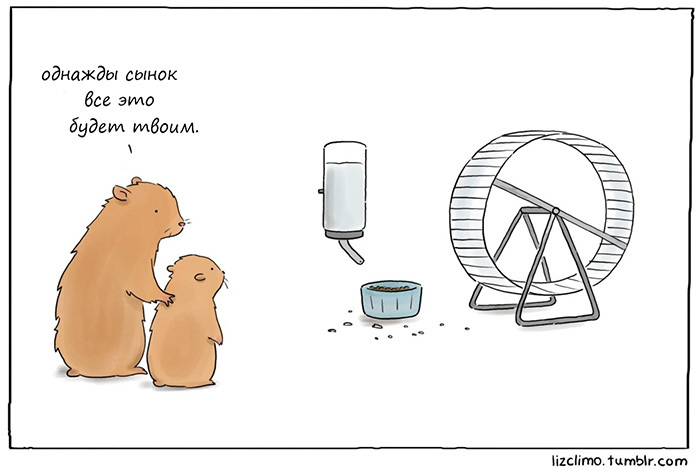
And then I wondered why someone has been building multibillion-dollar companies in 5 years, and someone (putting in plus or minus as much effort) is marking time? Here in this post and I want to share with you my experience and thoughts. I do not pretend to be objective, but this experience has been plagued by 5 years of leadership of the company, the birth of 2 beautiful children and the launch of our new project.
Back in 2010, it became clear that without some kind of system, without some kind of approach, it was impossible to cope with a bunch of incoming tasks:
I started google, read and try different approaches. I read Gleb Arkhangelsky, a bunch of articles about Getting Things Done on Habr, etc. It took about 3 years to implement a system of planning and execution of tasks, adapt it for yourself and cultivate the habit of doing all this. There were several approaches, it took a fair amount of self-discipline and perseverance - but the results, in conjunction with the rest of the principles, now suit me.
I started the implementation of the system with the method of Vasya Kisloi . Who is this wonderful person who made this document, I do not know. This material was written a long time ago, when there was no iPhone yet and contains some archaisms, but I adopted this approach almost completely.
To automate the planning and task management process, I use the mobile and desktop version of this Doit.im application . There is a free version or paid for only $ 20 per year. For processing and storing physical documents, I have trays and folders corona with files (just like in the method of Vasya Sour). For storing docks in electronic form, there are Evernote and Dropbox.
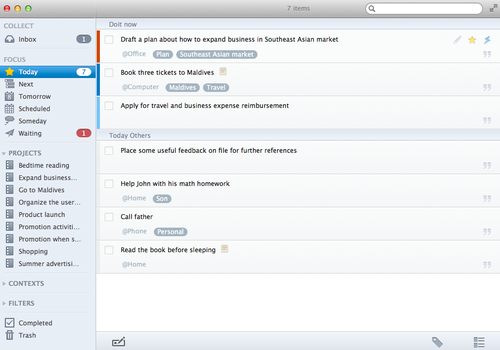
And so, when I set it all up, I began to actually do many tasks a day. And when I worked in this mode for a couple of months, I realized that it is not enough to do MANY tasks, it is much more important to do CORRECT tasks. If you have implemented the system correctly, then at any time you have tasks that need to be done. Those. to do everything is impossible a priori. Quantity should grow into quality.
This article on Habr’s about Zen GTD and Mind maps of Maxim Kolpakov with an abstract of the book came to help me (I did not find the source, so I posted it in Dropbox). It became obvious to me how important the role of planning, analysis and reflection is.
The planning scheme is very simple:
What do we get as a result? In an ideal world, with this approach, every action, every sneeze that we do leads us to large and global goals.
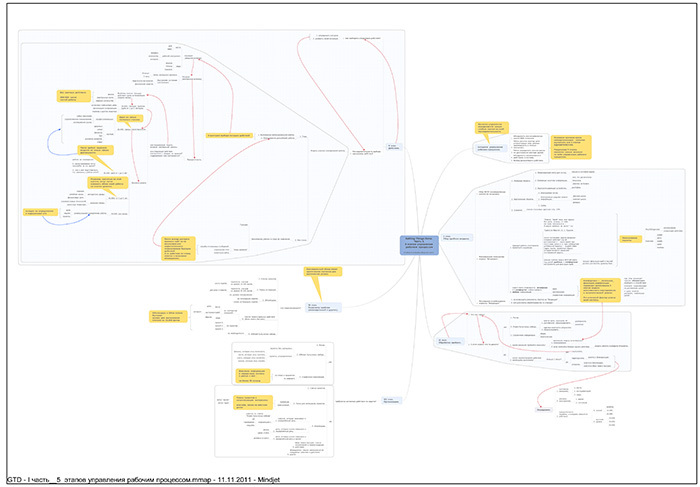
And a couple of life hacks from personal practice. Every morning, when I plan my 1-3 key tasks for the day for each of them, I ask the following questions:
As a result, it’s important not the number of tasks done, but the final result (I call it “exhaust”) of your activity. You could figure out a month without bending your head without days off, marking tasks as completed. But in fact, this is your heroism that really does not give movement forward (I immediately remembered the blogger).
The formula from the name of this principle was spied by the guys from Business Youth. I do not really like them, but they formulated a very important thing in such a simple presentation. The meaning of this formula is that your real effectiveness depends on whether you can get the maximum “maximum return” (max profit) at the minimum cost (min cost)!
I always tried to do only those 20% of the tasks that give the greatest "exhaust" that really move you or your project forward. Those 20% that allow you to grow qualitatively. This approach applies to everything. For example, if we are talking about the functionality of our ticket system, then we try to do 20% of the features that provide 80% of the value of the product.
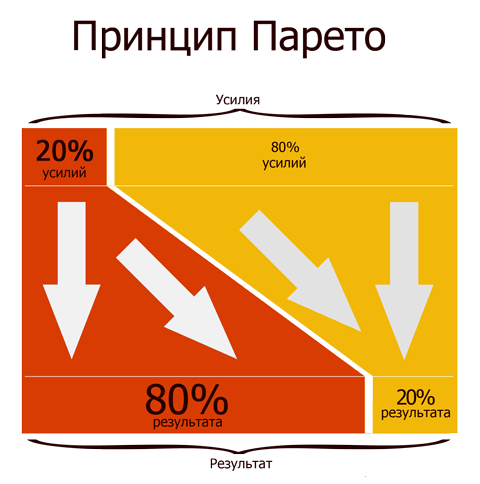
The denominator of this formula is the second interesting number, which makes you think about how we can get the maximum result at minimum cost. How to do something with minimal resources? Due to the fact that once we thought about it, we were able to make the first version of the system in 2 months and 37,500 rubles .
It is the conditional numbers in the numerator and denominator of this formula that ultimately determine how efficiently you work and live.
Karl Philippe Gottlieb von Clausewitz
When I was engaged in various Internet projects 5-6 years ago, I asked myself the question: “Can I do the same by the age of 30 to earn $ 10 million, and by 40 - $ 100 million.” The answer was NO. Yes, at that time there was a good income, but in order to get to the cherished goal, you need to radically change your occupation, you need to change the approach to business.
This third principle is very cool to apply when you rested somewhere and can’t overcome the wall, can’t get the desired result. For example, if your business model initially does not work (strategic miscalculation), then no investment and a super team will help you. Dramatic changes are needed.
Small tactical successes and failures with the right strategy add up to a significant result. While the same success, but with a strategic miscalculation will lead to collapse. This picture perfectly illustrates.
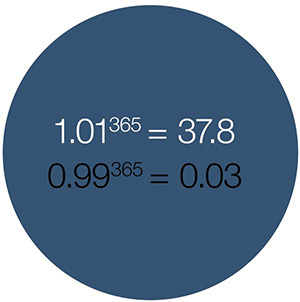
Actually in this mode, I have been working since the end of 2014. This approach allows you to achieve a certain balance between work, leisure and family. These principles do not allow me to work 4 hours a day (I work 8-10), they allow me not to work 12-14 hours a day without exhaust. I am sure that it is still far from true effectiveness. But, as they say, there is no limit to perfection.
Over the past 5 years, a person’s earnings have not only not increased, but even decreased slightly. All these years, he continued to do the same: selling links from sites, contextual advertising, affiliate programs, etc. For a student in 2008, earning $ 800 / month was quite a good income. But it's already 2015, and the guy has the same $ 700-800!

And then I wondered why someone has been building multibillion-dollar companies in 5 years, and someone (putting in plus or minus as much effort) is marking time? Here in this post and I want to share with you my experience and thoughts. I do not pretend to be objective, but this experience has been plagued by 5 years of leadership of the company, the birth of 2 beautiful children and the launch of our new project.
1. Plan and carry out the planned
Back in 2010, it became clear that without some kind of system, without some kind of approach, it was impossible to cope with a bunch of incoming tasks:
- Wife calls: "Buy a loaf, milk and ...".
- I received an email confirming the meeting next week at 16-30.
- Friend Vasya must repay the day after tomorrow, if he does not repay, remind.
- I promised to prepare a presentation before the end of the month, I must not forget.
- And a million other things that are simply impossible to remember.
I started google, read and try different approaches. I read Gleb Arkhangelsky, a bunch of articles about Getting Things Done on Habr, etc. It took about 3 years to implement a system of planning and execution of tasks, adapt it for yourself and cultivate the habit of doing all this. There were several approaches, it took a fair amount of self-discipline and perseverance - but the results, in conjunction with the rest of the principles, now suit me.
I started the implementation of the system with the method of Vasya Kisloi . Who is this wonderful person who made this document, I do not know. This material was written a long time ago, when there was no iPhone yet and contains some archaisms, but I adopted this approach almost completely.
To automate the planning and task management process, I use the mobile and desktop version of this Doit.im application . There is a free version or paid for only $ 20 per year. For processing and storing physical documents, I have trays and folders corona with files (just like in the method of Vasya Sour). For storing docks in electronic form, there are Evernote and Dropbox.

And so, when I set it all up, I began to actually do many tasks a day. And when I worked in this mode for a couple of months, I realized that it is not enough to do MANY tasks, it is much more important to do CORRECT tasks. If you have implemented the system correctly, then at any time you have tasks that need to be done. Those. to do everything is impossible a priori. Quantity should grow into quality.
This article on Habr’s about Zen GTD and Mind maps of Maxim Kolpakov with an abstract of the book came to help me (I did not find the source, so I posted it in Dropbox). It became obvious to me how important the role of planning, analysis and reflection is.
The planning scheme is very simple:
- Every year I make a global plan for the year, where I fix the key things that I want to achieve. These tasks / projects should be fully consistent with the goals for 5 years, which I also review once a year.
- Next, I cut the annual plan to a quarterly one, where from big goals I switch to specific projects that I have to do in each quarter.
- Then at the beginning of each quarter, I divide the goals and projects of the quarter into specific tasks to be completed in the current quarter.
- Well, in the end, at the beginning of each month a detailed plan for the month for all active projects is made.
What do we get as a result? In an ideal world, with this approach, every action, every sneeze that we do leads us to large and global goals.

And a couple of life hacks from personal practice. Every morning, when I plan my 1-3 key tasks for the day for each of them, I ask the following questions:
- Why am I doing this? A security question that allows you to understand the whole chain to the quarterly and annual goals for this particular task.
- How can I not do this at all? If, however, the task must be completed, you need to think about it, maybe it can be somehow automated. Maybe she is now not so important and urgent, although it leads to the goal.
- Who can I instruct to do this? And finally, if the task leads to the goal and it needs to be done right now, can it be assigned to someone? Can someone make it better / faster / cheaper?
As a result, it’s important not the number of tasks done, but the final result (I call it “exhaust”) of your activity. You could figure out a month without bending your head without days off, marking tasks as completed. But in fact, this is your heroism that really does not give movement forward (I immediately remembered the blogger).
2. MM = Max profit / Min cost
The formula from the name of this principle was spied by the guys from Business Youth. I do not really like them, but they formulated a very important thing in such a simple presentation. The meaning of this formula is that your real effectiveness depends on whether you can get the maximum “maximum return” (max profit) at the minimum cost (min cost)!
I always tried to do only those 20% of the tasks that give the greatest "exhaust" that really move you or your project forward. Those 20% that allow you to grow qualitatively. This approach applies to everything. For example, if we are talking about the functionality of our ticket system, then we try to do 20% of the features that provide 80% of the value of the product.

The denominator of this formula is the second interesting number, which makes you think about how we can get the maximum result at minimum cost. How to do something with minimal resources? Due to the fact that once we thought about it, we were able to make the first version of the system in 2 months and 37,500 rubles .
It is the conditional numbers in the numerator and denominator of this formula that ultimately determine how efficiently you work and live.
3. You can’t achieve the goal - change the approach
“Strategic miscalculations cannot be compensated for by tactical successes”
Karl Philippe Gottlieb von Clausewitz
When I was engaged in various Internet projects 5-6 years ago, I asked myself the question: “Can I do the same by the age of 30 to earn $ 10 million, and by 40 - $ 100 million.” The answer was NO. Yes, at that time there was a good income, but in order to get to the cherished goal, you need to radically change your occupation, you need to change the approach to business.
This third principle is very cool to apply when you rested somewhere and can’t overcome the wall, can’t get the desired result. For example, if your business model initially does not work (strategic miscalculation), then no investment and a super team will help you. Dramatic changes are needed.
Small tactical successes and failures with the right strategy add up to a significant result. While the same success, but with a strategic miscalculation will lead to collapse. This picture perfectly illustrates.

Actually in this mode, I have been working since the end of 2014. This approach allows you to achieve a certain balance between work, leisure and family. These principles do not allow me to work 4 hours a day (I work 8-10), they allow me not to work 12-14 hours a day without exhaust. I am sure that it is still far from true effectiveness. But, as they say, there is no limit to perfection.
